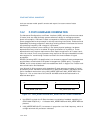
14-4 Vol. 3
POWER AND THERMAL MANAGEMENT
// This example does not cover the additional logic or algorithms
// necessary to coordinate multiple logical processors to a target P-state.
TargetPstate = FindPstate(PercentPerformance);
if (TargetPstate != currentPstate) {
SetPState(TargetPstate);
}
// WRMSR of MCNT and ACNT should be performed without delay.
// Software needs to exercise care to avoid delays between
// the two WRMSRs (for example, interrupts).
WRMSR(IA32_MPERF, 0);
WRMSR(IA32_APERF, 0);
14.3 SYSTEM SOFTWARE CONSIDERATIONS AND
OPPORTUNISTIC PROCESSOR PERFORMANCE
OPERATION
An Intel 64 processor may support a form of processor operation that takes advan-
tage of design headroom to opportunistically increase performance. In Intel Core i7
processors, Intel Turbo Boost Technology can convert thermal headroom into higher
performance across multi-threaded and single-threaded workloads. In Intel Core 2
processors, Intel Dynamic Acceleration can convert thermal headroom into higher
performance if only one thread is active.
14.3.1 Intel Dynamic Acceleration
Intel Core 2 Duo processor T 7700 introduces Intel Dynamic Acceleration (IDA). IDA
takes advantage of thermal design headroom and opportunistically allows a single
core to operate at a higher performance level when the operating system requests
increased performance.
14.3.2 System Software Interfaces for Opportunistic Processor
Performance Operation
Opportunistic processor operation, applicable to Intel Dynamic Acceleration and Intel
Turbo Boost Technology, has the following characteristics:
• A transition from a normal state of operation (e.g. IDA/Turbo mode disengaged)
to a target state is not guaranteed, but may occur opportunistically after the


















